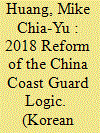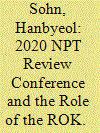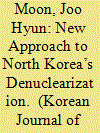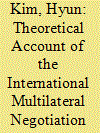|
|
|
Sort Order |
|
|
|
Items / Page
|
|
|
|
|
|
|
| Srl | Item |
| 1 |
ID:
167951


|
|
|
|
|
| Summary/Abstract |
In June 2018, the Chinese government initiated a new round of reforms to reshuffle
the leadership of the China Coast Guard (CCG) so as to better administer the
country’s blue territory. In contrast to the 2013 structural reform of the Chinese
government which created the CCG and made it part of the State Oceanic
Administration, a sub-ministerial organ of the Chinese State Council, the 2018
reform placed the agency under direct command of the Communist Party’s Central
Military Commission. This paper argues that the CCG today has been a formidable
maritime giant and acquired a fair ability to coordinate its patrol operations with
other agencies in recent years. In particular, the maritime law enforcement force
has been made more militarized given its close association with the Chinese
Navy. Nonetheless, despite the notable performance the CCG has made, it still
faces problems of unclear legal status and weak airborne surveillance capabilities,
keeping its institutional reform far from full completion. Moreover, a more
powerful coast guard force can on the one hand facilitate Beijing’s aim to become
a great maritime power but on the other hand lead to more security challenges as a
harsher maritime contest between China and its strategic competitors is likely to be
witnessed in the near future.
|
|
|
|
|
|
|
|
|
|
|
|
|
|
|
|
| 2 |
ID:
167949


|
|
|
|
|
| Summary/Abstract |
The purpose of this paper is to assess the strategic environment of the Republic
of Korea (ROK) and to examine what strategies the ROK will develop ahead of
the 2020 NPT Review Conference. Nuclear arms control policy-making is very
complex for the ROK because of its specific security dilemma. And the role and
strategy of the ROK in international regimes are increasingly important for the
ROK’s security and status in the world. Thus, the Treaty on the Non-Proliferation
of Nuclear Weapons and its review process including the Review Conference and
Preparatory Committee are particularly essential to the ROK. In 2020 when the
10th Review Conference will be held, the ROK should present an appropriate
strategy. For this, this article first outlines the establishment and development of the
NPT and its review process from 1995 to 2015, after the Cold War and the North
Korean nuclear issue was raised. And it describes the ROK’s role played in the
NPT on the basis of its three pillars and suggests what strategies Korea must retain:
Nuclear disarmament and security assurances from Russia and China; Coercing the
Democratic People’s Republic of Korea (DPRK) to rejoin the NPT; Continuing the
momentum of the Nuclear Security Summit; and Setting and leading a new agenda.
This study concludes with a forecast that the year 2020 will be a major turning point
for Korea.
|
|
|
|
|
|
|
|
|
|
|
|
|
|
|
|
| 3 |
ID:
167946


|
|
|
|
|
| Summary/Abstract |
This paper analyzes the background of the nuclear stalemate between Trump and
Kim in the Hanoi Summit and investigates various issues involving North Korean
denuclearization, including a detailed roadmap and proper compensation for
Pyongyang. The paper uses tree cardinal perspectives of analytical tools (the will of
the leader, nuclear capability, and nuclear strategy) to critically assess North Korea’s
nuclear weapons program and fathom Kim Jong Un’s stance on denuclearization.
The United States reaffirms CVID/FFVD principles regarding North Korea’s
WMD, while Pyongyang prefers an action-for-action method of denuclearization.
Although Pyongyang has announced an end to its nuclear testing and has shut down
nuclear facilities, experts question whether Pyongyang really is dismantling its
nuclear program. Pyongyang’s hidden nuclear facilities and accumulation of HEU
in numerous places, the complicated process of verification, as well as potential
traps in the details of the denuclearization agreement pose a big challenge. In light
of the current nuclear stalemate, President Moon’s mediating effort to bring Kim
Jong Un back to the denuclearization table is imperative.
|
|
|
|
|
|
|
|
|
|
|
|
|
|
|
|
| 4 |
ID:
167952


|
|
|
|
|
| Summary/Abstract |
This article examines the civil war in Syria and Iran’s military buildup in that
country through the lens of senior Israeli politicians, military officers, and security
pundits. Most of them agree that the Netanyahu government’s policy of striking
Iran–linked targets in Syria hard while encouraging Europe to impose, like the
United States, debilitating sanctions on Iran has severely damaged the ayatollahs’
plans. By interrupting Iranian efforts to establish a Hezbollah-like force in Syria
and equip it with precision-guided missiles, Israeli policy has also decreased, some
pundits believe, the likelihood of regional war. However, this article suggests that
although Israel’s policy has hindered Iranian entrenchment in Syria, the danger of
regional war has increased. Debilitating sanctions could cause Iran to discard the
2015 nuclear deal, thereby provoking an Israeli strike on its nuclear installations,
and increasingly bolder strikes in Syria may spur the ayatollahs to retaliate harshly.
Reliant upon Iran to secure Assad’s victory, but determined to deny the ayatollahs
control over Syria, Russia is allowing Israeli strikes to continue as it rehabilitates
Assad’s forces and rearms them with advanced weaponry. This weaponry, including
S-300 defense systems that threaten Israeli planes, could embolden Syria to attempt
recapturing the Golan Heights in the future.
|
|
|
|
|
|
|
|
|
|
|
|
|
|
|
|
| 5 |
ID:
167953


|
|
|
|
|
| Summary/Abstract |
The Non-commissioned Officer (NCO) is regarded as the core of military combat
forces performing their duties at the front-line of defense, but the recent drop in
applications and enrollment of Army NCOs has hampered the acquisition and
operation of the workforce. As a way to solve this problem, the Army is paying
attention to job security and has been implementing the “Long-Term service NCO
upon commissioning” recruiting system in the second half of 2018. In this study,
we surveyed 1,492 young and active duty soldiers considering the above problems
and current situation, and empirically analyzed what factors, including occupational
safety, would undermine the applications and enrollment of Army NCOs. The
results of the analysis showed that low occupational status, low job security, a
lack of trust in the military, inadequate career and career development conditions,
uncomfortable work environment and region, and hierarchical culture of the
military have had an influence over the recent drop in applications and enrollment
of Army NCOs. In addition, the McNemar test was conducted to further analyze
the effectuality of the incentive for people to apply to become Army NCOs. As
a result of the analysis, it was confirmed that in all groups, the effect the “LongTerm service NCO upon commissioning” recruiting system was far better than the
traditional recruiting system. Based on the results of the above study, several policy
proposals have been suggested to improve the acquisition of the Army NCO.
|
|
|
|
|
|
|
|
|
|
|
|
|
|
|
|
| 6 |
ID:
167947


|
|
|
|
|
| Summary/Abstract |
Despite the Hanoi Summit between Donald Trump and Kim Jong Un, there has
been no positive sign that the North Korea nuclear problem is being resolved. To
advance the denuclearization negotiations, a new approach to denuclearization
must be considered, which needs to meet two objectives simultaneously: to relieve
North Korea’s concerns about its regime change and to practically eliminate its
nuclear capability to fabricate additional nuclear weapons and refurbish existing
nuclear weapons. The new approach should consider infrastructures that would
be indispensable in implementing North Korea’s denuclearization processes and
stopping any attempt to proliferate North Korea’s nuclear materials and technologies
amid denuclearization. Accordingly, this paper proposes a new roadmap whose
key concept is to first disable and, then, gradually but completely dismantle the
lynchpin nuclear facilities within 10 years. Here, lynchpin facilities are defined as
key facilities that are directly related to the production of nuclear materials or other
materials used when fabricating and refurbishing the key components of nuclear
weapons or which would have a fatal impact on maintaining North Korea’s nuclear
weapon program. Additionally, this roadmap addresses corresponding measures
for denuclearization activities. This roadmap consists of three sub-periods: the
lynchpin disablement period, verification and dismantling period, and manifest
threat removal period. This paper also identifies and incorporates into the roadmap
the supporting infrastructure and possible corresponding measures to accompany
the denuclearization steps.
|
|
|
|
|
|
|
|
|
|
|
|
|
|
|
|
| 7 |
ID:
167950


|
|
|
|
|
| Summary/Abstract |
The years 2017–2019 have been remarkable in the long stand-off with North Korea,
as much for the drama of war-threats and then summits, as for the durability of the
North Korean status quo. Indeed, given all the sturm-und-drang of both hawkish
and then dovish approaches to North Korea since 2017, the greatest surprise is how
little both alternatives have accomplished ‘on the ground.’ This essay investigates
surprise—why is the North Korean status quo so persistent? Specifically, why
have the hawkish and dovish deviations from the status quo since 2017 so failed
to change much? Several hypotheses derived from levels of analysis theory in
international relations are suggested. In brief, a leader level analysis would focus
particularly on Trump’s personality—his swings of interest, his personalistic
bargaining style, his sloth, his chaotic staffing. A domestic analysis would identify
the divisions within both the United States and South Korea over policy toward
the North. And a structural answer would posit the value of nuclear deterrence
as the cause particularly of Trump’s failure to budge Pyongyang. Because North
Korean intentions, particularly Kim’s psychological preferences, are only poorly
discernible, assigning causal weight to each hypothesis is quite difficult so long as
the North’s opacity persists. Hence this essay focuses on concept and hypothesis
development while nonetheless laying out what evidence there is.
|
|
|
|
|
|
|
|
|
|
|
|
|
|
|
|
| 8 |
ID:
167948


|
|
|
|
|
| Summary/Abstract |
This article aims to explain the multilateral negotiations of the Treaty on the
Prohibition of Nuclear Weapons, which was adopted at the UN General Assembly
on July 7, 2017, from the model of institutional bargaining. Its findings are: first,
non-nuclear states’ sense of frustration and crisis about the failure of progress on
nuclear disarmament under the NPT regime served as a critical momentum to move
towards the negotiations. Second, consensual knowledge about the humanitarian
effects of nuclear weapons and solutions served as a driving force behind
embarking on the negotiations. Third, the leadership by a core group of pro-ban
non-nuclear countries was effective in mobilizing political support and facilitating
the timely conclusion of the negotiations. Fourth, a salient solution of a simple
and robust treaty, and a bridging solution to allow any country in possession of
nuclear weapons to join the treaty before their elimination contributed to the prompt
agreement on the treaty. Fifth, clear and effective compliance measures regarding
non-nuclear states facilitated the conclusion of the negotiations, whereas the lack
of clear and effective compliance measures regarding state parties possessing
nuclear weapons rather contributed to the timely end of the negotiations. Finally, a
fast-track approach, a single-text negotiating strategy, and an issue decomposition
strategy were effective in reaching consensus on the treaty text.
|
|
|
|
|
|
|
|
|
|
|
|
|
|
|
|
|
|
|
|
|